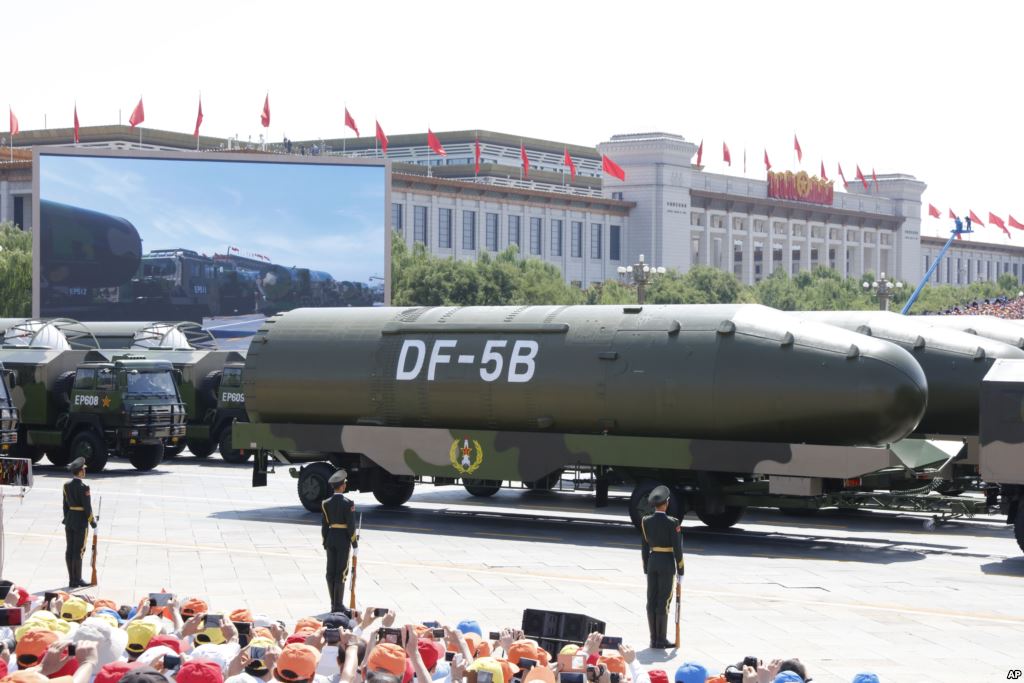 Military vehicles carry DF-5B ICBMs Photo Credit: Voice of America
Military vehicles carry DF-5B ICBMs Photo Credit: Voice of America
China’s Missile Silo Expansion Is a Race Against the U.S.’ and Russia’s Nuclear Arsenals
Reports of China’s missile silo expansion are mounting. The country is rapidly modernizing its arsenals and investing in new weapons capabilities. On July 26, the Federation of American Scientists (FAS) used satellite images and announced the discovery of a large number of nuclear missile silos under construction near Hami in the northwestern region of Xinjiang. According to the report, the discovery of “the silo construction at Yumen and Hami constitutes the most significant expansion of the Chinese nuclear arsenal ever.” These concerns were already raised by the Pentagon back in 2020. The Pentagon’s 2020 annual report stated that China’s nuclear warhead stockpile is expected to at least double in size in the next decade.
As reported by the Stockholm International Peace Research Institute (SIPRI) in January 2021, China now has 350 nuclear warheads, an increase of 30 from the previous year. Overall, according to FAS, about “91 percent of all nuclear warheads are owned by Russia and the U.S.,” each of which are believed to have approximately 4,000 warheads in their military stockpiles. While China has significantly fewer nuclear warheads, the country’s rapid nuclear build-up suggests that Beijing appears to be rethinking its position in this regard.
For the U.S., China’s increasingly expansionist course is a cause of concern. On April 20, Admiral Charles Richard, head of the U.S. Strategic Command, voiced his concern about China’s plans before the Senate Committee on Armed Services, calling the country’s nuclear build-up an “unprecedented expansion.” Later in August, Adm. Richard spoke of “a strategic breakout in China,” referring to the country’s “explosive growth and the modernization of its nuclear and conventional forces,” which he described as “breathtaking.” Similarly, on August 6, State Department spokesman Ned Price reported on Secretary Blinken’s attendance at the ASEAN Regional Forum Foreign Ministers’ Meeting. He pointed to Blinken’s deep concern about the rapid growth of China’s nuclear arsenal, as the country disregards its decades-old nuclear strategy based on minimum deterrence. China’s intentions are thus called into question.
In the midst of this nuclear expansion, the U.S. and Russia have extended the New START arms control treaty by five years to February 2026. But all attempts to bring China to the nuclear negotiating table failed. Beijing showed no interest and was unwilling to participate in the negotiations unless Washington and Moscow significantly reduced their arsenal to bring them in line with China’s own level.
Thus, while the U.S. is worried about China’s nuclear build-up, China feels outclassed and wants to ensure its nuclear deterrent can remain effective. Beijing clearly thinks that it is important to strengthen its overall nuclear deterrence capability and adapt its arsenal to that of the U.S. and Russia. The country is trying to consolidate its status as a great power and likely believes that its previous policy of minimal deterrence is no-longer sufficient. With its rapid expansion, the country may want to show its opponents that its deterrent is credible and that its nuclear arsenal is not vulnerable to being disabled by a preemptive first strike. China’s nuclear build-up could also be seen as one of the country’s responses to the modernization efforts of other world powers that are also striving to upgrade and boost their capabilities. At the same time, the country could use its improved nuclear arsenal as leverage to strengthen its position for possible future negotiations. In this way, the country has something that can be negotiated away and, in turn, get desired concessions from the U.S. and Russia.
The most critical question here is, how all of these will impact arms control, the Nuclear Nonproliferation Treaty, and the U.S. Nuclear Posture Review. While it is certain that the U.S. and Russia have no immediate interest in adjusting their arsenals to China’s level, it would be equally naive to believe that China would not try to expand too. The country developed its economic and technological strength, and now appears to be investing more in its nuclear strategy.
Nevertheless, China’s nuclear build-up could fuel arms competition and make efforts to get China involved in international arms control even more difficult. On top of that, its growing nuclear arsenal may give it the confidence to make bolder moves in high-tension situations. Continued dialogue between the U.S. and China is important, and multilateral negotiations are critical for the success of future negotiations. Washington must find a constructive way to work closely with its allies and partners to advance common interests, to meet the challenges of China’s growing influence, and to prevent unexpected crises.





